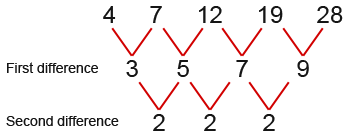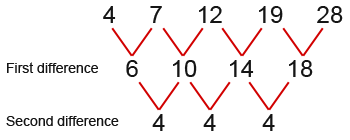Quadratic Sequences
What is a Quadratic sequence?
Each number in a sequence is known as a term. We identify a term by its position in the sequence. For example the first term is the term that occurs first in a sequence. The 5th term is the term that occurs in the fifth place of the sequence.
In an arithmetic (linear) sequence the difference between each term is constant while in a quadratic sequence the difference between each term is not constant The following sequence is known as an arithmetic sequence
While the following sequence of numbers is known as a Quadratic sequence
Important rules
There a few basic rules you should follow when trying to find a formula that can be used to find the nth term in a sequence, i.e the 6th or 100th term in a quadratic sequence.
- Halve the second difference to get the number of n2s for example if you the second difference of a sequence is +6 (which would be constant) you would divide 6 by 2 to get 3 therefore this becomes 3n2
In fact the following rules apply when determining the number of n2s
- If the second difference is 2, you start with n2.
- If the second difference is 4, you start with 2n2.
- If the second difference is 6, you start with 3n2.
- Write out the original sequence above the terms of your number of n2
- Subtract the n2s from the sequence to give the Residue
- The residue will either be constant or a linear sequence. If it is a linear sequence then work out its formula.
- Finally add the number of n2s to the formula for the residue and this will be the formula for the original sequence.
Basic examples
Find a general expression for the nth term of the following sequence;
![]()
The differences between these terms in the sequences are not equal. This must mean that the sequence is not linear as it does not increase in equal steps as shown below;

We can see that the difference of this sequence changes at each step as it increases. Suppose we found the second difference;

The second difference of the sequence is constant. It does not change as the first difference. If the second difference is constant the sequence is referred to as a quadratic sequence, and therefore contains a n2 term.
Here is the sequence again and the terms labelled;

In the sequence above we can see that the first term is a 4, second term is a 7, third term is 19, and the fifth term is 28. Let’s find n2 below;

If you look at the sequence you will realise that the sequence is always 3 more than n2 term as shown below;

This must mean that the rule to find any nth term in this sequence is;
![]()
We can prove this;

The above shows that our rule to find the nth term in the above sequence is valid.
Find an expression for the nth term of the following sequence;
![]()
First we find the first difference as we did above;

Then we find the second difference;

We can see that the second difference has a constant increment of 4. This must mean that it’s a quadratic sequence and therefore as an n2
Now it’s find the n2 next and compare;

Here we can see that when we compare the n2 sequence with the original sequence the outcome is not constant, we have to change n2 to make sure that it does. Let’s try 2n2;

Now we have found a link by using 2n2. We can see that the sequence is always 5 more than the 2n2 sequence. Therefore the formula to find any nth term in this sequence is;
![]()
In the last example there was a twist. And you must familiarise yourself with this. In the first sequence we saw that the second difference was a 2 therefore we use n2. In the last example the second difference was 4 we found that 2n2 gave us a link to use with the sequence. You must use this trial and improvement method when this occurs to make sure that the link is always constant. If you continue to practice you will realise that;
- When the second difference is 2 the sequence starts with n2
- When the second difference is 4, the sequence starts with 2n2
- When the second difference is 8, the sequence starts with 4n2
And so on… Therefore you always halve the second difference to get the number of n2s for example if the second difference of a sequence is +4 (which would be constant) you would divide 4 by 2 to get 2 therefore this becomes 2n2
Harder examples (linear residues)
In a sequence the difference between the terms and the number of n2s my not be constant but maybe linear. If the sequence is linear then we work out the nth term for the linear difference and add it to the n2s which becomes the nth term of the quadratic sequence.
We take the same steps as we did above. We have to find the first and second difference.
Look at the second difference we can see that just 1 n2 is involved since…
We continue as we did before by finding the difference between n² and the sequence terms
The residue is not constant. We therefore have to find the nth term of the residue. Given that;
We simply add the residue nth term to n². So given the sequence;
…the nth term of the sequence is;
First find the first difference and then the second difference of the sequence;
Since the second difference is constant that must mean at the sequence is a quadratic sequence. Therefore the sequence involves n² We divide the second difference by two to determine the number of n² involved;
Therefore the nth term starts with 5n²…
We must now work out how the the sequence is from n²
Notice that the residue is not constant here. We therefore have to find the nth term of the residue.
Therefore;
You can prove it for your self by finding all the terms in the original sequence.

when i first saw this i thought that i was never going to understand it since im hopeless at maths.
but really , this site is great and i really do understand quadratic equations now !!
but what if there is more than one nth term
Hey,
Thanks for the article! Very helpful!
I was wondering what level this work is? And is there another quadratic sequence where you have to find a b and c?
Please help.
Thanks,
Lucie Mcroosy
Hello Lucie,
Glad you liked the article.
This level is what 18-19 would probably do. It is college level maths or equivalent to A level.
I didn’t quite understand your last question.
This is for 18-19 years old students
wow,-i’ve fairly recently started year 8 and we’re learning this- i came here for help with my homework i had to find the nth term of two quadratic sequences
1))0,5,12,21,32-Which i think the answer is n2+2n-3
2)0,3,10,19,36
I’m having a lot of trouble with Q.2
PLEASE HELP!
sorry
just ignore my last comment 🙁 ive read on
Hello Jason,
Yes the first one is correct:
\[ n^2 + 2n -3 \]
Are you sure you have written the second sequence correctly?
May be the sequence is:
\[ 0, 3, 10, 21, 36 \]
So then you will get;
\[ 2n^2 – 3n + 1 \]
I thought I add the answer for you as well since you have spent a lot of time on it.
Hello Author,
Thanks for your answer. Don’t worry about my last question, I was probably dreaming.
Thanks ever so much,
Lucie Mcroosy.
🙂
This is only level 7/8 maths at best. That is equivalent to C/B grade at GCSE. However, you would need to have something that includes a more complicated equation so that you could find “b” as well as “c” for the formula. I’ve just taught this to my year 8’s (12 year olds) but they are top set.
Thanks for the reply Jon,
Your answer is better. I wasn’t sure this was in GCSE and 12 years old exams.
Hey there Mr Jon
Well, I am 12 and second to top set. Top set does level 8, second does level 7. There are 6 sets altogether. We’ve learnt about the a b c. I think ‘a’ its a half the answer from the differences of the differences. ‘C’ is find the 0 term number. And I think ‘b’ is the hardest one-i think you have to do some simplifying and replacing the N’s with term number 1?
Am I wrong? I’ve kinda forgotten.
Lucie Mcroocy 🙂 🙂 🙂
Hi, What is the second difference is a constant but it is -5. for example,
Terms 4, -1, -11, -26, -46
Difference -5, -10, -15, -20
2nd Diff -5, -5, -5
How would N to the power of 2 come into this? Help. thanks.
Hi,
There are no examples of how to handle such a situation.
The nth term is: ½(-5n² + 5n + 8)
I really don’t understand why the n^ thing changes depending on the number? i’ve got online maths homework to do and i have to get over 80% and im just so confused:(((( This helped me a bit but im still so confused
link to a good online calculator for this??
the question is
12 , 25 , 42 , 63 , 88
can u pls help me find the sequence ?
Hello Chasm,
You must show that you have tried so that we know where you’re stuck. Have you tried it? So you will need to find the first difference. You do that by subtracting the previous term from the next term. For example:
\[ 25-12=13, 42-25=17, 63-42=21, 88-63=25 \]
So now you know that the first difference is:
\[ 13, 17, 21, 25 \]
Using the examples above, I am sure you can continue from here.
Hi, what about the sequence : 3,10,21,36,55 ?
Hi,
You must show that you tried. Start by finding the first difference. Have you tried that?
Hi!
The example that you’ve shown is to find the nth term of nonlinear sequence with positive second difference. How about sequence with negative second difference? Like this………..
Terms: 36, 35, 32, 27, 20, 11
Difference: -1, -3, -5, -7, -9
2nd difference: -5, -5, -5, -5
How to find?
Hi,
I have this sequence: 2.7,15,26..
The second difference is 3 and I’m not sure what to do?!
I have worked on this equation for the past hour.
9,13,13,9,-11,-27,-47
I am in Grade 9 High Level IGCSE Maths, and I can’t do this equation. I know the second difference is -4, and so according to Un=an^2+bn+c, a should be -2. But I can’t figure out b or c; a+b is supposed to be 4 (the first difference) and a+b+c should be 9 (the first term) and so b SHOULD be 6 and c SHOULD be 5 but it simply doesn’t seem to match up to the equation. I really have tried this all, but it isn’t working. PLEASE HELP! Our teacher likes to challenge us, and I’ve done the rest of the homework but this one has got me completely stuck.
There is another way to solve this quadratic sequence faster and easier.
hi whats the nth term of -1, 3, 11, 23, 39? i have tried but cant work it out?